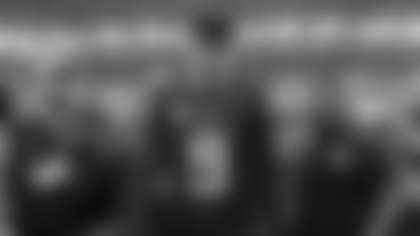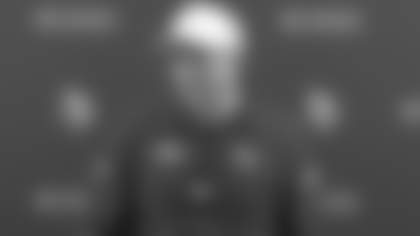The "NFL 100 Greatest" series is airing on NFL Network from Weeks 2-11 of 2019, the NFL's 100th, with two, one-hour episodes airing back-to-back each Friday night and will count down the greatest across five categories: Plays (Sept. 13 & Sept. 20), Games (Sept. 27 & Oct. 4), Characters (Oct. 11 & Oct. 18), Game-Changers (Oct. 25 & Nov. 1) and Teams (Nov. 8 & Nov. 15).
The NFL and the Associated Press (AP) came together to select the 100 greatest in the five categories, comprising an 80-person blue-ribbon panel. In addition to the rankings, NFL Films conducted more than 400 interviews with celebrities, current NFL stars and Legends.
The Vikings had five plays make the list of No. 51-100 that aired Sept. 13, including the "Miracle at the Met," which occurred Dec. 14, 1980. Last week, the "Minneapolis Miracle" landed as the ninth-best single play ever.
The Miracle at the Met refers to the 46-yard touchdown reception by Ahmad Rashad, who corralled a Hail Mary pass by Tommy Kramer that was tipped by Browns safety Thom Darden for a 28-23 Vikings victory.
It turns out the action that happened before the final snap of the day was good enough to get that game into the top 100 of all-time. It landed at No. 96 overall.
The Vikings trailed 13-0 in the third quarter when Kramer connected with Joe Senser for a 31-yard touchdown. The PAT was no good, however.
The Browns added a 32-yard field goal, and the Vikings followed with one from 24 yards later in the period.
Cleveland, which needed to win the game in order to win the AFC Central, then took a 23-9 lead midway through the fourth quarter on a 1-yard run by Cleo Miller.
Kramer led the Vikings 72 yards on five plays, finishing the drive with a 7-yard touchdown pass to Ted Brown, but Rick Danmeier's extra point kick was blocked.
Long before the 2-point conversion was added to the NFL rule book, the 23-15 deficit meant that the Vikings would need two scores to win.
Bobby Bryant intercepted Brian Sipe at the Cleveland 41 with 2:18 remaining, and the Vikings again scored in five plays, with Kramer finishing the drive with a 12-yard pass to Rashad. Danmeier's PAT was good, making it 23-22, but the onside kick was unsuccessful.
Minnesota's defense forced a punt, and the Vikings were helped when the ball reached the end zone for a touchback.
That left just 14 seconds to go 80 yards.
Grant and Offensive Coordinator Jerry Burns turned to a play developed by assistant coach Les Steckel, who coached receivers, tight ends and the kicking game from 1979-83 before being hired as Vikings head coach in 1984.
The ink in Steckel's pen was frozen on this day when the temperature was 23 degrees Fahrenheit with a Wind Chill of 11 at kickoff, so he rehashed the patterns and details in the dirt on the sidelines. He named the seldom-practiced play Squadron Left 50 Hook & Lateral (not "ladder" as it's sometimes mistakenly called) in the Vikings playbook.
On the sideline, the always-colorful Burnsie told Grant the plan was to run 'Les' [expletive] play.'
It involved a bit of deception and misdirection, with placing receivers Rashad, Sammy White and Terry LeCount along the right side of the formation. Senser was in-line to the left of the left tackle, and running back Ted Brown stood in the backfield, right of center.
Senser was instructed to delay his release before running a hook route, and Brown also was instructed to delay before starting toward the right then heading underneath Senser's hook pattern.
"Teddy Brown ran over and wanted to make sure I wanted him to delay and come out the back side opposite of where Joe Senser was," Steckel told Vikings.com during a phone interview in 2018. "It was something I had never seen before, but I was confident it was going to work."
Kramer was supposed to look to the right, moving defenders toward the receiving trio before firing to Senser on his left.
As intended, Senser caught the ball and pitched it back to Brown as the running back hit full stride, angling for the sideline. Brown made it to the Cleveland 46 and stepped out to stop the clock with four seconds remaining.
Steckel said he had a high level of confidence in Senser and Brown being able to execute their aspects of the play and leave enough time for one more snap.
"[Brown] understood why I wanted him to go out to release outside away from where Joe was, so they never saw him coming," Steckel said. "Once Tommy went back and looked to the Squadron side with Terry LeCount, Ahmad Rashad and Sammy White, then he turned to throw the ball to Joe … I knew Joe would catch the ball and wisely lateral the ball.
"When he did, Teddy timed it perfectly and caught the lateral and ran up the field enough for us to just heave it down the field for a Hail Mary," Steckel added.
The Vikings use of 11 personnel (one running back, one tight end, three receivers) that season was ahead of its time and came in handy in the clutch.
Minnesota kept the personnel on the field for the final chance, again lining the receivers in the Squadron to the right.
Kramer dropped back and heaved the ball from his own 47-yard line. Darden tipped it at the Cleveland 5. Rashad secured it and stayed on his feet, gracefully back-stepping his way into the end zone.
Rashad's silky-smooth concentration, reflexes and coordination sent Metropolitan Stadium into a frenzy and the Vikings back to the playoffs via the 11th division title under Head Coach Bud Grant.
Players received $5,000 bonuses for winning the NFC Central, which they wrapped up in the next-to-last week of the regular season.
NFL Films interviewed Rashad for the episode. His recollection follows:
"It was freezing cold. I don't think I went out for warmups — just wait, and go out there and play when the game starts," Rashad recalled. "It was a very exciting game.
"Tommy Kramer called this play Squadron Right, and it was a play where it was a Hail Mary play, and in my mind, that play was all about me. I remember taking off when he called the snap. I was running, and I hear the crowd started to roar. I start picking up speed, thinking he must have thrown the ball. I look up and hear the people cheering, and I see no ball. I look on the other side of the field, and I see our running back running out of bounds. All I know now is I can barely breathe, and when I get back to the huddle, they call the same play again.
"I see the defender jump up and tap it. As I go by, I just reach out and grab it and then just kind of tip in for the touchdown, and it was over. Years later, people remember the Miracle at the Met, and to the better part of that, it's just one of life's true highlights."















